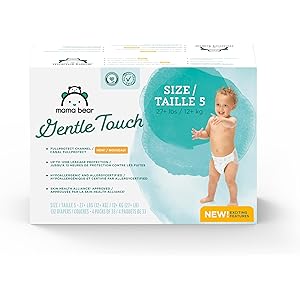Amazon Brand - Mama Bear Gentle Touch Diapers, Size 5, 132 Count (4 packs of 33)
$33.60 (as of October 25, 2025 00:05 GMT +00:00 - More infoProduct prices and availability are accurate as of the date/time indicated and are subject to change. Any price and availability information displayed on [relevant Amazon Site(s), as applicable] at the time of purchase will apply to the purchase of this product.)Understanding Contractions in Pregnancy
Contractions are a natural part of the labor process, signaling that the body is preparing for childbirth. They are rhythmic tightening and relaxing of the uterine muscles, which help to push the baby down the birth canal. Understanding the different types of contractions can empower expectant mothers to better navigate their labor experience.
Types of Contractions: Braxton Hicks vs. Labor Contractions
There are two primary types of contractions that pregnant individuals may experience: Braxton Hicks contractions and true labor contractions. Braxton Hicks, often referred to as “practice contractions,” can occur as early as the second trimester. They are usually irregular and infrequent, serving as a way for the body to prepare for actual labor. In contrast, true labor contractions are consistent, increasing in intensity and frequency as labor progresses.
When Do Contractions Start?
Contractions typically begin in the third trimester, although some women may experience them earlier. The onset of contractions can vary greatly among individuals. For some, they may start weeks before labor, while others may not feel them until labor is imminent. It’s essential for expectant mothers to track their contraction patterns to distinguish between Braxton Hicks and true labor.
How to Time Your Contractions
Timing contractions is crucial for determining when to head to the hospital or birthing center. A common method is to note the start time of one contraction and the start time of the next. This helps in calculating the frequency and duration of contractions. Generally, if contractions are occurring every five minutes for at least an hour, it may be time to seek medical attention.
What Do Contractions Feel Like?
Contractions can feel different for everyone, but they are often described as a tightening sensation in the abdomen. Some women report feeling pressure in their lower back or pelvis. As labor progresses, these sensations may become more intense and painful, often radiating to other areas of the body. Understanding these sensations can help women prepare mentally for the labor experience.
Managing Contractions During Labor
There are various techniques to manage contractions during labor, including breathing exercises, movement, and relaxation techniques. Many women find comfort in changing positions, using a birthing ball, or taking warm showers. Additionally, pain relief options such as epidurals or medications can be discussed with healthcare providers to find the best approach for each individual.
Signs That Contractions Are Becoming More Intense
As labor progresses, contractions will typically become more intense and closer together. Signs that contractions are becoming more intense include increased pain, a feeling of pressure in the pelvis, and a change in the pattern of contractions. Recognizing these signs can help women understand that they are moving closer to delivery.
What to Expect After Contractions Begin
Once contractions begin, it’s essential to stay informed about what to expect. The early stages of labor can last several hours, and it’s normal for contractions to fluctuate in intensity. As labor progresses, the body will go through different stages, including the dilation of the cervix and the eventual delivery of the baby. Understanding this process can help alleviate anxiety and prepare for the journey ahead.
Common Myths About Contractions
There are many myths surrounding contractions that can lead to confusion. One common myth is that all contractions are painful; however, some women experience mild discomfort. Another myth is that contractions always indicate immediate labor, but as mentioned earlier, Braxton Hicks contractions can occur well before true labor begins. Educating oneself about these myths can help expectant mothers feel more confident and prepared.
Consulting with Healthcare Providers
It’s crucial for pregnant individuals to maintain open communication with their healthcare providers regarding contractions. Regular check-ups can help monitor the health of both mother and baby, and healthcare providers can offer personalized advice on what to expect during labor. Being proactive in discussions about contractions can lead to a more informed and positive birthing experience.



